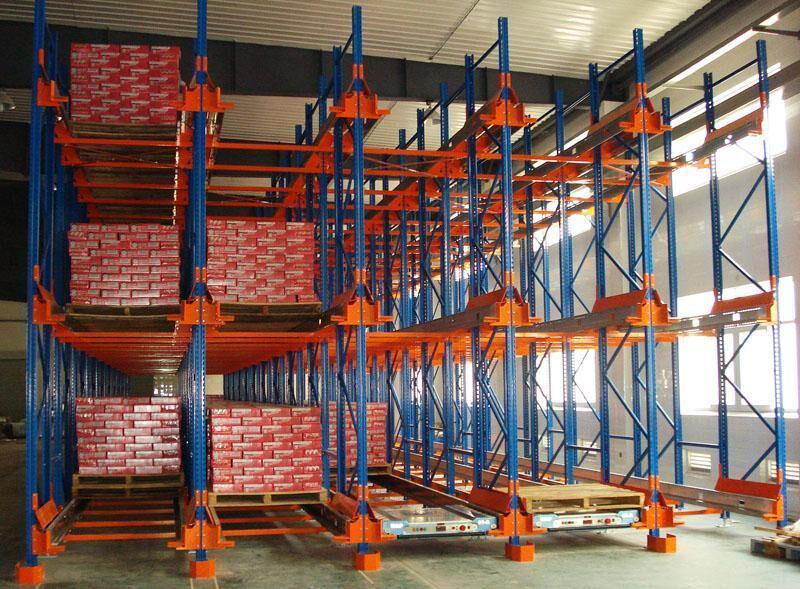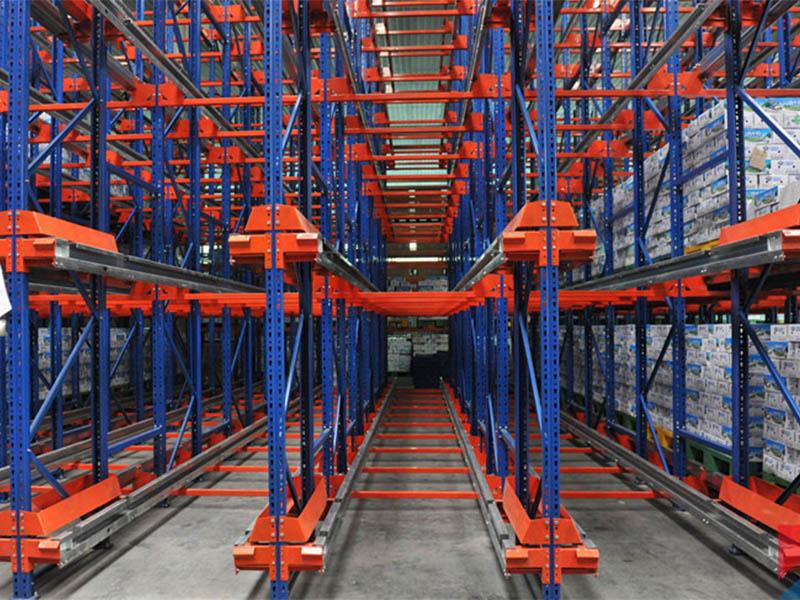In the high-stakes world of logistics, manufacturing, and distribution, efficient space utilization is paramount. The backbone of this efficiency lies in the industrial racks for warehouse operations. Far more than simple shelves, these engineered structures are the critical infrastructure that transforms vast warehouse floors into organized, accessible, and high-density storage hubs. Choosing the right industrial warehouse racking system directly impacts productivity, safety, inventory accuracy, and ultimately, the bottom line. This comprehensive guide explores the essential aspects of industrial racks for warehouse environments, empowering you to make informed decisions for your storage needs.

1. Defining Industrial Racks for Warehouse: Purpose and Core Functionality
Industrial racks for warehouse are specialized, heavy-duty structures designed to store palletized goods, large parts, or bulk materials safely and efficiently within commercial and industrial storage facilities. Unlike light-duty retail shelving, they are engineered to handle significant weights – often thousands of pounds per pallet position – and withstand the rigors of forklift traffic, seismic activity (in specific regions), and constant loading/unloading cycles.
The core purpose of industrial warehouse racking is to:
Maximize Vertical Space: Utilize the often-underused cubic volume of a warehouse, freeing up valuable floor space for operations.
Improve Accessibility: Provide organized lanes and selective access to stored inventory, reducing travel time for order pickers and forklifts.
Enhance Organization: Create a systematic storage layout that facilitates inventory control and management (e.g., through Warehouse Management System - WMS - integration).
Protect Inventory: Keep goods off the floor, minimizing damage from moisture, impacts, and pests. Proper racking also prevents product collapse.
Increase Efficiency & Throughput: Enable faster put-away, storage, and retrieval processes, streamlining overall warehouse operations.
Support Safety: Engineered systems, when properly installed and used, provide a safer storage environment than unorganized floor stacking.
2. Major Types of Industrial Warehouse Racking Systems
Selecting the right type of industrial racks for warehouse is crucial. Each system offers distinct advantages suited to different inventory profiles, turnover rates (FIFO vs. LIFO), and operational goals:
Selective Pallet Racking: The most common and versatile industrial warehouse racking system. It offers direct access to every pallet position via aisles. Forklifts can enter the aisles to store or retrieve any pallet at any time. Ideal for warehouses with a high SKU count and diverse inventory requiring frequent access to all items. Variations include conventional narrow-aisle (requiring specialized forklifts) and wide-aisle.
Drive-In/Drive-Thru Racking: Designed for high-density storage of homogeneous products with lower selectivity. Forklifts drive directly into the rack structure to deposit or retrieve pallets, which are stored on rails. Drive-In (LIFO - Last-In, First-Out) has an entrance at one end only. Drive-Thru (FIFO - First-In, First-Out) has entrances at both ends. Maximizes space but reduces immediate access to all pallets. Excellent for bulk storage of items like beverages or seasonal goods.
Push-Back Racking: A dynamic, high-density industrial racks for warehouse solution operating on a LIFO basis. Pallets are loaded onto wheeled carts nested on inclined rails. When a new pallet is loaded, it pushes the previous pallets back. When unloading, the next pallet moves forward. Offers better selectivity than Drive-In while still providing good density. Ideal for medium-turnover inventory with multiple SKUs per lane.
Pallet Flow Racking: A high-density, high-throughput FIFO system. Pallets are loaded at the higher end of an inclined rail system and move forward by gravity on rollers or wheels to the unloading end. Ideal for high-volume operations with perishable goods or items requiring strict FIFO rotation (e.g., food, pharmaceuticals).
Cantilever Racking: Specifically designed for long, bulky, or irregularly shaped items that cannot be palletized easily, such as lumber, pipes, steel, furniture, or rolls of carpet. Features long horizontal arms (cantilevers) extending from vertical columns. Provides unobstructed access from the sides.
Mobile Pallet Racking (Mobile Aisle): Entire rows of industrial warehouse racking are mounted on powered mobile bases that move laterally on rails embedded in the floor. Only one access aisle is opened at a time, significantly increasing storage density (up to 80% more than selective racking). Requires specialized controls and safety systems. Ideal for cold storage or archives where space is extremely expensive.
Mezzanine Flooring with Racking: Effectively creates a second or third level within the warehouse footprint. Industrial racks for warehouse can be integrated underneath, around, or even on top of the mezzanine structure, maximizing vertical cube utilization for both storage and operational space.

3. Critical Factors: Load Capacity, Dimensions & Specifications
Industrial racks for warehouse systems are engineered structures, and understanding their technical specifications is non-negotiable for safety and performance:
Load Capacity (UDL - Uniformly Distributed Load): The maximum weight each beam level and the overall bay structure is designed to safely support. This is specified per pallet position and per bay. Never exceed the rated UDL. Consider both the weight of the product and the pallet itself.
Pallet Size & Weight: The dimensions (length, width, height) and maximum weight of the pallets being stored dictate the required beam length, vertical spacing (beam levels), and overall rack configuration. Include overhang in your calculations.
Beam Length & Height: Beam length must accommodate the pallet width (including overhang) plus necessary clearance. Adjustable beam levels allow customization of vertical storage space based on pallet height.
Frame Depth & Upright Height: Frame depth must accommodate the pallet depth plus clearance. Upright height determines the overall storage height, constrained by building clearances and sprinkler requirements.
Bay Width: The horizontal space between upright frames, determining how many pallets fit side-by-side per level. Standard is typically 8 or 9 feet for two pallets.
Seismic Considerations: In earthquake-prone zones, industrial warehouse racking must meet specific seismic design codes (e.g., RMI/ANSI MH16.1 in the US) which dictate frame bracing, anchorage, and load capacities. Professional engineering review is often required.
Forklift Clearance: Adequate aisle width and vertical clearance are critical for safe forklift operation within the industrial racks for warehouse system.
4. Materials, Construction & Safety Features
The durability and safety of industrial racks for warehouse systems hinge on materials and design:
Materials: Primarily constructed from high-strength structural steel (A36 or A1011). Components are roll-formed into specific shapes (channels, tees) for strength and rigidity. Thickness (gauge) varies based on load requirements. Galvanized or powder-coated finishes provide corrosion resistance.
Key Components:
Uprights/Frames: Vertical columns with punched holes for beam connectors. Braced for lateral stability.
Beams: Horizontal members that support the pallets. Feature end connectors that lock into the uprights.
Beam Connectors: Devices (tear-drop, structural bolt, safety-lock) that secure beams to uprights.
Row Spacers & Braces: Connect adjacent frames for longitudinal stability.
Decking: Wire mesh, plywood, or steel panels placed on beams to support smaller items or unstable pallets. Crucial for safety.
Column Protectors/Guards: Steel guards bolted to upright bases to absorb forklift impacts and prevent structural damage.
Pallet Supports: Wire or steel bars spanning between beams to prevent pallets from tipping or falling through.
Essential Safety Features:
Load Signs: Clearly display the maximum permissible load per level per bay. Mandatory.
Beam Safety Locks: Secondary locking mechanisms (pins, clips) preventing beams from accidentally dislodging if the primary connector fails or is impacted.
Anchor Bolts: Securely bolt upright bases to the concrete floor to resist seismic forces and prevent tipping. Installation must follow engineered specifications.
Aisle Definers & Guardrails: Mark aisles clearly and protect uprights at aisle ends from impacts.
Netting & Falling Object Protection: Installed beneath rack levels or in pick modules to catch falling debris or items.
5. Choosing the Right Industrial Racks for Your Warehouse: Key Considerations
Selecting the optimal industrial warehouse racking system requires a thorough analysis:
Inventory Profile: SKU count, pallet dimensions, weight, turnover rate (FIFO/FIFO needs), homogeneity, special handling requirements.
Throughput Requirements: Volume of goods moving in and out daily/weekly. Impacts choices between high-density (slower access) vs. high-selectivity (faster access) systems.
Warehouse Characteristics: Building dimensions (clear height, column spacing, floor condition), ceiling obstructions (sprinklers, lights, HVAC), location (seismic zone), and available floor space.
Material Handling Equipment (MHE): Type of forklifts (reach trucks, counterbalance, turret trucks) determine required aisle widths and impact rack configuration (e.g., VNA racking for very narrow aisles).
Budget: Includes cost of racking components, installation, potential floor preparation (leveling, cutting for anchors), and any required MHE upgrades. Consider Total Cost of Ownership (TCO) including maintenance and potential future reconfiguration.
Scalability & Flexibility: Will your needs change? Systems like selective racking are easier to reconfigure than drive-in or push-back.
Safety & Compliance: Adherence to local building codes, fire regulations, and industry standards (e.g., RMI in the US) is paramount. Factor in the cost of necessary safety accessories.
6. Installation, Maintenance, and Damage Prevention
Proper implementation is key to unlocking the benefits of industrial racks for warehouse:
Professional Installation: Always use certified installers following the manufacturer's specifications and engineered drawings. Proper leveling and anchoring are critical for structural integrity.
Regular Inspections: Implement a documented inspection program:
Pre-Operational Checks: Forklift operators should visually inspect racks before starting work.
Routine Inspections: Conducted weekly/monthly by warehouse staff for obvious damage or issues.
Formal Inspections: Performed quarterly/annually by qualified personnel (internal or external) following a detailed checklist (e.g., RMI guidelines). Document all findings.
Damage Protocol: Establish a clear process for reporting and assessing damage. Never use damaged racking. Tag it out immediately. Minor damage might be repairable by qualified technicians following manufacturer guidelines; significant damage usually requires component replacement.
Preventative Measures:
Rigorous forklift operator training.
Strict enforcement of speed limits and safe operating procedures within aisles.
Use of high-quality column protectors/guards.
Ensuring pallets are undamaged and correctly positioned on beams.
Never overloading beams or exceeding UDL.
Using decking where required.
Keeping aisles clear of obstructions.
7. The Future: Trends in Industrial Warehouse Racking
The world of industrial racks for warehouse continues to evolve:
Automation Integration: Racking systems are increasingly designed to integrate seamlessly with Automated Storage and Retrieval Systems (AS/RS), Automated Guided Vehicles (AGVs), and goods-to-person technologies.
Advanced Materials & Design: Research into stronger, lighter materials and optimized structural designs allows for taller, denser configurations with potentially lower material costs.
Data-Driven Optimization: Sensors on racks (monitoring load, impact, stability) combined with WMS data provide insights for optimizing storage layouts, predicting maintenance needs, and enhancing safety.
Sustainability Focus: Use of recycled steel, more durable coatings to extend lifespan, and designs facilitating easier disassembly/reconfiguration for reuse contribute to greener warehousing.
Modular & Scalable Solutions: Growing demand for systems that can be easily expanded or reconfigured as business needs change rapidly.
Industrial racks for warehouse are far more than passive storage; they are the active, engineered framework upon which efficient, safe, and profitable warehouse operations are built. Selecting the right system involves a careful evaluation of your specific inventory, operational flow, facility constraints, and budget. From versatile selective racking to high-density drive-in systems and specialized cantilever designs, the options are diverse. Prioritizing proper specification, professional installation, rigorous maintenance, and unwavering adherence to safety protocols is non-negotiable. By understanding the intricacies of industrial warehouse racking outlined in this guide, you can make strategic investments that optimize your storage space, enhance productivity, protect your valuable inventory and workforce, and provide a scalable foundation for your logistics success. Remember, your racking system is the backbone of your warehouse – choose wisely and maintain it diligently.







